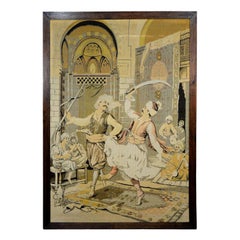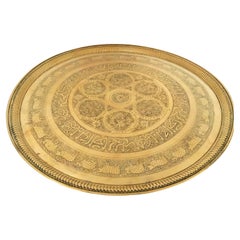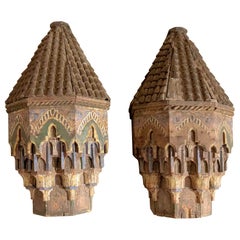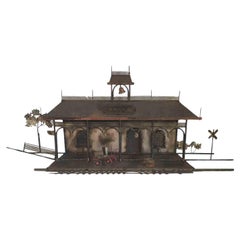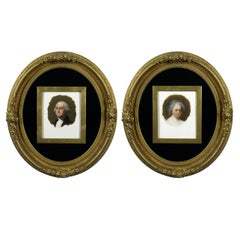Carved Decorative Art
Early 20th Century German Rustic Carved Decorative Art
Tapestry, Wood
19th Century Indian Moorish Antique Carved Decorative Art
Brass
Mid-17th Century English Tudor Antique Carved Decorative Art
Wood, Oak
19th Century Moroccan Antique Carved Decorative Art
Wood
1970s American Brutalist Vintage Carved Decorative Art
Metal, Brass
Late 19th Century German American Colonial Antique Carved Decorative Art
Porcelain, Gesso, Giltwood
Early 1900s Russian Modern Antique Carved Decorative Art
Gold, Silver
18th Century Italian Antique Carved Decorative Art
Wood, Paper
1950s Vintage Carved Decorative Art
Wood
Late 19th Century English Victorian Antique Carved Decorative Art
Glass, Wood
Late 18th Century English Antique Carved Decorative Art
Canvas, Wood, Paint
21st Century and Contemporary Italian Louis XVI Carved Decorative Art
Wood, Paint
1930s American Folk Art Vintage Carved Decorative Art
Wood, Paint
18th Century Italian Rococo Antique Carved Decorative Art
Gold Leaf
18th Century Dutch Dutch Colonial Antique Carved Decorative Art
Gold Leaf
Late 19th Century Italian Antique Carved Decorative Art
Terracotta, Wood, Walnut
19th Century English Antique Carved Decorative Art
Mahogany, Giltwood
19th Century Italian Antique Carved Decorative Art
Wood
19th Century Rustic Antique Carved Decorative Art
Walnut
18th Century Italian Baroque Antique Carved Decorative Art
Wood
1890s French Art Nouveau Antique Carved Decorative Art
Metal, Brass, Copper
1850s French French Provincial Antique Carved Decorative Art
Paper
Mid-20th Century French Carved Decorative Art
Ceramic
Late 18th Century French Louis XVI Antique Carved Decorative Art
Giltwood
1810s Scandinavian Biedermeier Antique Carved Decorative Art
Wood, Paint, Glass
Late 19th Century Italian Medieval Antique Carved Decorative Art
Wood
18th Century Italian Baroque Antique Carved Decorative Art
Gold Leaf
Early 20th Century American Carved Decorative Art
Canvas, Wood
19th Century German Victorian Antique Carved Decorative Art
Gesso, Canvas, Giltwood
18th Century French Rococo Antique Carved Decorative Art
Canvas, Wood, Giltwood, Paint
Mid-20th Century Unknown Carved Decorative Art
Porcelain, Wood
Mid-19th Century French Black Forest Antique Carved Decorative Art
Walnut
1910s Chinese Qing Vintage Carved Decorative Art
Marble
2010s European Modern Carved Decorative Art
Marble, Bronze
17th Century Belgian Antique Carved Decorative Art
Oak, Paint
19th Century German Louis XVI Antique Carved Decorative Art
Porcelain, Giltwood
1820s Japanese Japonisme Antique Carved Decorative Art
Wood
Late 18th Century English Antique Carved Decorative Art
Glass, Wood, Paper
Mid-18th Century Italian Baroque Antique Carved Decorative Art
Fruitwood
1890s French Louis XVI Antique Carved Decorative Art
Bronze
Late 19th Century Japanese Japonisme Antique Carved Decorative Art
Shell, Bone, Mother-of-Pearl, Lacquer
Early 19th Century French Antique Carved Decorative Art
Giltwood, Wood
19th Century Japanese Meiji Antique Carved Decorative Art
Metal, Brass, Bronze, Iron
Early 19th Century Spanish Antique Carved Decorative Art
Wood
21st Century and Contemporary Italian Modern Carved Decorative Art
Marble, Carrara Marble, Copper
21st Century and Contemporary American Carved Decorative Art
Wood, Lacquer
16th Century Italian Renaissance Antique Carved Decorative Art
Walnut
1930s Swiss Expressionist Vintage Carved Decorative Art
Wood
19th Century German Antique Carved Decorative Art
Porcelain, Giltwood
Early 20th Century Chinese Carved Decorative Art
Teak
Early 20th Century English Art Deco Carved Decorative Art
Marble, Iron
Late 20th Century Italian Carved Decorative Art
Wood, Pine
18th Century Portuguese Baroque Antique Carved Decorative Art
Wood
1880s French Antique Carved Decorative Art
Wood
2010s North American Bauhaus Carved Decorative Art
Walnut
21st Century and Contemporary European Rustic Carved Decorative Art
Metal
19th Century French Greco Roman Antique Carved Decorative Art
Composition
18th Century French Antique Carved Decorative Art
Wood
Early 19th Century Italian Neoclassical Antique Carved Decorative Art
Wood
1890s French Art Nouveau Antique Carved Decorative Art
Enamel
Read More
At Colonial Williamsburg, Everything Old Is New Again
With the help of a new director, the Virginia institution's folk art and decorative arts museums are undergoing extensive upgrades.
New York’s Hirschl & Adler Showcases the American Workmanship and Design Panache of Neoclassical Treasures
The gallery's latest exhibition proves that museum-quality pieces entice and inspire, whether in traditional or more modern interiors.
